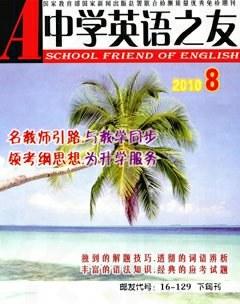关于反意疑问句的几点补充
樊德成
《牛津初中英语》教科书对反意疑问句的构成方法只作了些基本的概括性的说明,笔者在此基础上再作以下几点说明,与同行们共同探讨。
一、反意疑问句中,如果后面的简短问句为否定形式,则be动词、情态动词、助动词一定要与not采取缩写形式。如:
正:You can sing many English songs, cant you?
误:You can sing many English songs, can not you?
二、英语习惯上在简短问句中采用与前面陈述句部分人称相对应的适当代词充当主语。如:
正:The children cant swim, can they?
误:The children cant swim, can the children?
三、There be句式的反意疑问句
There isnt water in the bottle, is there?
There were many students in the classroom, werent there?
四、祈使句的反意疑问句的构成
1.祈使句是肯定形式时,后面的简短问句既可用肯定形式,也可用否定形式。如:
Close the window, will(wont) you?
Let us go home, will(wont) you?
提醒大家注意的是:以Let us的缩写形式(Lets)开头的祈使句的反意疑问句中,后面的简短问句用“shall we?”。如:
Lets go to school, shall we?
2.祈使句是否定形式时,简短问句要用肯定形式。如:
Dont read in the sun, will you?
五、陈述句中含有never/no/nobody/nothing/nowhere/hardly/seldom/few/little/neither…nor等否定词或含有否定意义的词时,形式上是肯定的,但意义上是否定的,所以后面的简短问句用肯定形式。如:
Tom could hardly tell the story in Chinese, could he?
但陈述句中带有否定词缀的词时,后面的简短问句仍要用否定结构。如:
She is unhappy, isnt she?
The boy is hopeless, isnt he?
六、当陈述句为“第一人称+think/believe/suppose/expect…+(that)宾语从句”结构时,后面的简短问句应根据“宾语从句”进行变换;如主句中的主语不是第一人称,则后面的简短问句与主句保持一致。如:
I believe he will be back in the month, wont he?
We didnt think you had done it, had you?
They thought Tom was a thief, didnt they?
七、当陈述句中含有have一词并表示“有”解时,后面的简短问句中英国人多用have的适当形式,美国人则用do的适当形式;如have表示一般动作,则后面的简短问句只能用do的适当形式。如:
Wang Hai has a new watch, hasnt/doesnt he?
Li Pings father had lunch at home yesterday, didnt he?
八、当陈述句中的谓语动词前有have/has(had) to时,则后面的简短问句用do的适当形式。如:
They have to wait for the next bus, dont they?
九、当陈述句中含有had better时,后面的简短问句用had的适当形式。如:
Youd better go and find him now, hadnt you?
十、当陈述句中出现dare/need时,如它们当作情态动词用时,后面的简短问句用情态动词的适当形式;如它们作实义动词用时,则后面的简短问句用do的适当形式。如:
They dare not walk through the forest alone, dare they?
She needs help, doesnt she?
十一、当陈述句部分是“I am…”时,后面的简短问句常用“arent I?”。如:
I am a student, arent I?
十二、当陈述句部分主语是someone/somebody/everyone/everybody/nobody等不定代词时,后面的简短问句中的主语用they;而当陈述句部分主语是something/everything/nothing等不定代词时,后面的简短问句中的主语用it。如:
Nobody came in, did they?
Everything is all right, isnt it?
十三、当must出现在陈述句中时,如must表示“必须、应当”之意时,后面的简短问句用must的适当形式;如must表示推测和判断,后面的简短问句须与must后的那个动词的适当形式相适应。如:
We must help each other, mustnt we?
He must be at home because the light in his room is on now, isnt he?

